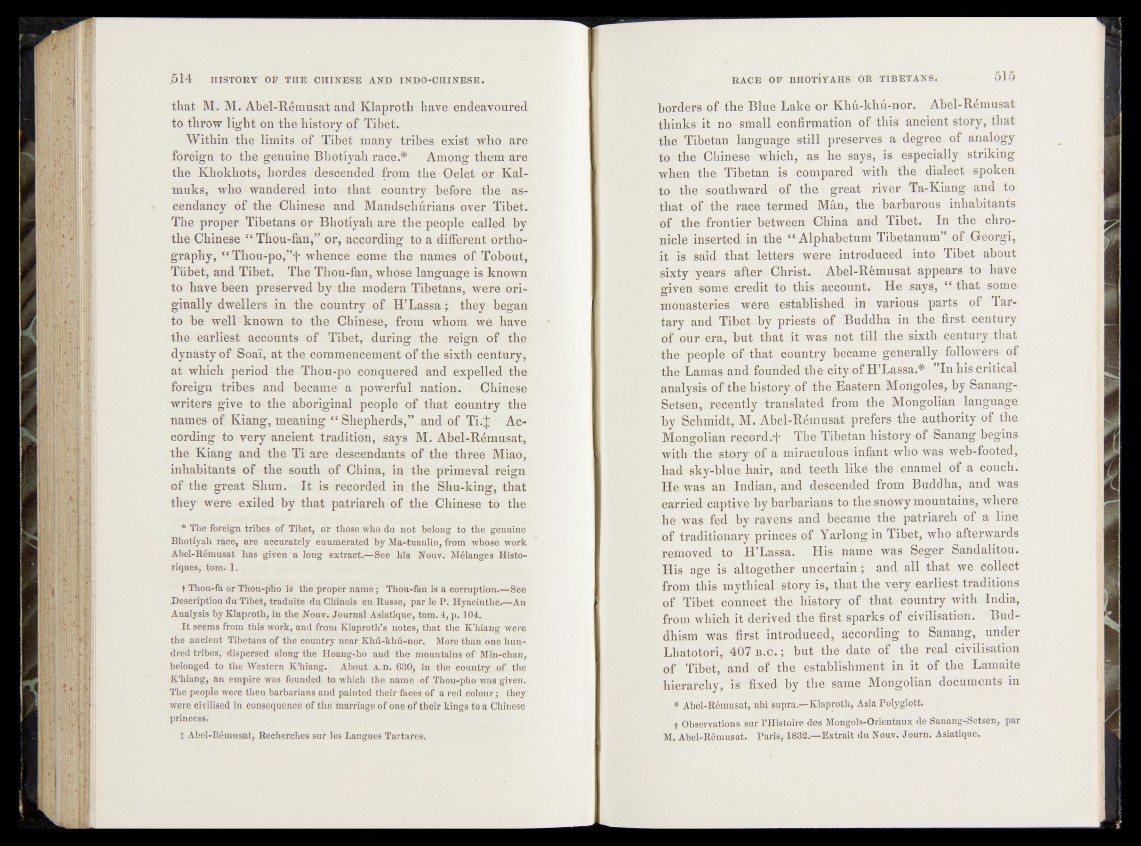
that M. M. Abel-Rémusat land Klaproth have endeavoured
to throw light on the history of Tibetois;
Within the limits of Tibet many, tribes exist who are
foreign to the genuine Bhotiyah race.^ Among them • are
the Khokbots, hordes descended, from tlie Öelet or Kal*
muks, who wandered into that country before rthe;, as*-
cendancy Of the Chinese and Mandschürians over Tibet.
The proper Tibetans or Bhotiyah are thepeople-ealled by
the Chinese “ Thou-fan,” or, according to a different orthography,
«‘Thou-po/’f whence come the names of Toboul,
Tiibet, and Tibet, The Thoudan, whose, language is known
to have been preserved by the modern Tibetans, were originally
dwellers in the country. of H’Lassa; they began
to be well known to the Chinese, .from whom we have
the earliest accounts of Tibet, during the :réign of .{the
dynasty of Soai, at the commencement of the sixth.century*
at which period the Thou-po conquered and expelled the
foreign tribes and became a powerful nation1. Chinese
writers give to the aboriginal people of that country thê-
names of Kiang, meaning “ Shepherds,loandrofTL^Ac-
cording to very aneient tradition, says M. Abel-Rémusat^
the Kiang and the Ti are descendants of the three ;Miao,
inhabitants of the south of Ohiiia, in the primeval reign
of the great Shun. It is recorded in the Sbu-king, that
they* were exiled by that patriarch of the Chinese te><fee
* The foreign tribes of Tibet, or those whó do not belong to tile genuine
Bhotiyah race, are accurately enumerated by Ma-tuanlin, fröih-^^hötó '^orh
Abel-Rémusat has given a long extract.—See his Nouv.' Mélftnges Bisto-
riques,tom. 1. ,
t Thou-fa or Thoti-pho is the proper name; Thou-fan is a corruption.— See
Description du Tibet, tradaite du CMnois eu Russe, par le P. Hyacinthe.—An
Analysis by Klaproth, in the Nouv. Journal Asiatique, tom. 4, p. 104.
It seems from this work, and from Klaproth’s notes, that the K’hiang were
the ancient Tibetans of^ the country near Khli-khü-nor. More thtfü oné hundred
tribes, dispensed along the Hoang-ho and the mountains of Min-chan,
belonged to the Western K’hiang. About A.D. 630, in the country of the
.K’hiang, an empire was founded to which tbe name of Thou-pho was given.
The people were then barbarians and painted their faces of a red colour •, they
were civilised in consequence óf the marriage of one of their kings to a Chinese
princess." _
i Abel-Rémusat, Recherches sar les Langues Tartares.
borders of‘the Blue Lake or Khü-khu-nor. Abel-Rémusat
thanks it no small confirmation of-this ancient story, that
tbe Tibetan language still preserves a degree of analogy
to !;ihe Chinese which, as be says, is especially striking
when tbe Tibetan is compared with tbe dialect spoken
to -the ' southward of tbe * great river Ta-Kiang and to
that qf the raee termed M&n,. tbe barbarous inhabitants
of the frontier between China and Tibet. In the chronicle
inserted in the “ Alphabetum Tihet.anum” of Georgi,
it is said that letters, weredntreduced. into Tibet about
sixty years after Christ. , Abel-Rémusat appears to have
given some credit to this account. He says, “ that some
monasteries were established in various parts of Tartary
and Tibet? by priests- of Buddha in" the first century?
óf .our era^ but that it was not ,till:tbe sixth;century that
the? people of that country became generally followers of
the Lamas and founded the cit-y^f H’Lassa.* ?”I<n his critical
ttebMstory/ófi^he.lksteiim ;Mong®les,;by Sanang-
Seièen’, recently translated- from the.Mongolian;language
by Schmidt, M. Abel-Rémusat prefers;the authority of the
Mongolian record-t The Tibetan history of Sanangtbegins
wife the >stco*y3af a miraculous ?infant who was web-footed,
haduky-hluehair, and. teeth like the enamel of a ^shch.
He was an Indian, and descended from Buddha, and was
carried captive byfbarbarians.t© the snowy mohutaras?, where
he was fed by ravens andrbecame thé. patriarch of a line
> of traditionary princes of Yarlong-in Tibet, who afterwards
removed- ..to H’Lassa. His name was Seger-Sandalitou.
His age is altogether uncertain; and .all that we collect
from this mythical story is^that the very earliest traditions
of Tibet connect the history of th at country with India,
from which it d#ived the first'sparks’ of civififetibn. Buddhism
was first introduced, according to Sanang, under
Lhatotori, 407 B .G .; but the date of the real civilisation
of Tibet; and of the establishment in it of the Lamaite
hierarchy, Is fixed by the same Mongolian documents in
* Abel-Rémusat, ubbaupra^Klaproth, Asia Polyglott.'
Observations sur 1’Ristèire des Mongols-Orientaux de Sanang-Betsen, par
M. Abel-Rémusat. Paris* 1882.—Extrait du Nouv; Journ. Asiatique.